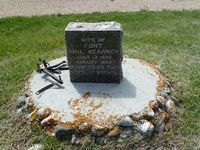Fort Phil Kearny: Difference between revisions
John Stanton (talk | contribs) m Text replace - "<seo metadescription="Historic US and Canadian fortifications" />" to "<seo metadescription="Historic US and Canadian fortifications" /> {| style="margin: 1em auto 1em auto" width="800px" |- | " |
Bot: Automated import of articles *** existing text overwritten *** |
||
| (3 intermediate revisions by one other user not shown) | |||
| Line 1: | Line 1: | ||
{{SocialNetworks}} | {{SocialNetworks}} | ||
{{PageHeader}} | {{PageHeader}}{{External|wikidata=Q5471828|wikipedia=Fort_Phil_Kearny}} | ||
'''Fort Phil Kearny (1866-1868)''' - Established as [[Fort Carrington]] by Colonel [[Henry B. Carrington]]<!-- not USMA --> of the [[18th U.S. Infantry]] in Jul 1866. Renamed for popular Union General, [[Philip Kearny]]<!-- not USMA -->, finally abandoned 31 Jul 1868. | '''Fort Phil Kearny (1866-1868)''' - Established as [[Fort Carrington]] by Colonel [[Henry B. Carrington]]<!-- not USMA --> of the [[18th U.S. Infantry]] in Jul 1866. Renamed for popular Union General, [[Philip Kearny]]<!-- not USMA -->, finally abandoned 31 Jul 1868. | ||
| Line 25: | Line 25: | ||
{| | {| | ||
| | | | ||
<googlemap version="0.9" lat="44.532738" lon="-106.82642" zoom="17" width="500" scale="yes" overview="yes" controls="large" icons="http://www.fortwiki.com/mapicons/icon{label}.png"> | <googlemap version="0.9" lat="44.532738" lon="-106.82642" zoom="17" width="-500" height="-500" scale="yes" overview="yes" controls="large" icons="http://www.fortwiki.com/mapicons/icon{label}.png"> | ||
(F) 44.532225, -106.826205 | (F) 44.532225, -106.826205,Fort Kearny | ||
Fort Kearny | (1866-1868) | ||
</googlemap> | </googlemap> | ||
|valign="top"| | |valign="top"| | ||
| Line 50: | Line 50: | ||
{{Visited|31 May 2010}} | {{Visited|31 May 2010}} | ||
__NOTOC__ | __NOTOC__ | ||
__NOEDITSECTION__ | __NOEDITSECTION__ | ||
{{PageFooter}} | |||
{{DEFAULTSORT:Phil Kearny}} | {{DEFAULTSORT:Phil Kearny}} | ||
[[Category:All]] | [[Category:All]] | ||
| Line 63: | Line 60: | ||
[[Category:Wyoming All]] | [[Category:Wyoming All]] | ||
[[Category:Wyoming Johnson County]] | [[Category:Wyoming Johnson County]] | ||
[[Category:Bozeman Trail]] | [[Category:Bozeman Trail]] | ||
[[Category:Wyoming Fort Trail]] | [[Category:Wyoming Fort Trail]] | ||
[[Category:{{PAGENAME}}]] | [[Category:{{PAGENAME}}]] | ||
[[Category:2010 Research Trip]] | [[Category:2010 Research Trip]] | ||
Latest revision as of 06:05, 26 February 2025
| More information at Warlike, Wikipedia
Fort Phil Kearny (1866-1868) - Established as Fort Carrington by Colonel Henry B. Carrington of the 18th U.S. Infantry in Jul 1866. Renamed for popular Union General, Philip Kearny, finally abandoned 31 Jul 1868.
History of Fort Phil KearnyBuilt to protect emigrants traveling the Bozeman Trail north to the gold fields of Montana, and also to prevent intertribal warfare between Native American tribes. Fort Phil Kearny was the largest of three forts constructed along the Bozeman Trail. The stockade enclosing the fort was 8' high, 1,496' long, 600' wide on the North end and 240' wide on the South end. Chief Red Cloud redoubled his efforts in the spring of 1867 against the three northern forts and travel on the Bozeman Trail was all but cut off. For over a year the southern forts had scarcely any communication from Fort C.F. Smith (1) except from one band of Crows that reported all was well. As a result of the military reversals and increasing pressure from the Indians under Red Cloud the U.S. Government capitulated and negotiated the 1868 Treaty of Fort Laramie, which resulted in the abandonment of the three northern forts (Fort Reno (2), Fort Phil Kearny, and Fort C.F. Smith (1)) and the cessation of travel on the Bozeman Trail. The Sioux Indians destroyed the three forts immediately after the troops had left the country. Current Status In 1963 the fort was designated a National Historic Landmark and today portions of the fort site and the Fetterman and Wagon Box battlefields are included within the Fort Phil Kearny State Historic Site boundaries. There is a partial restoration of the front of the stockade and one "bastion".
Sources:
Links:
Visited: 31 May 2010
| ||||||


